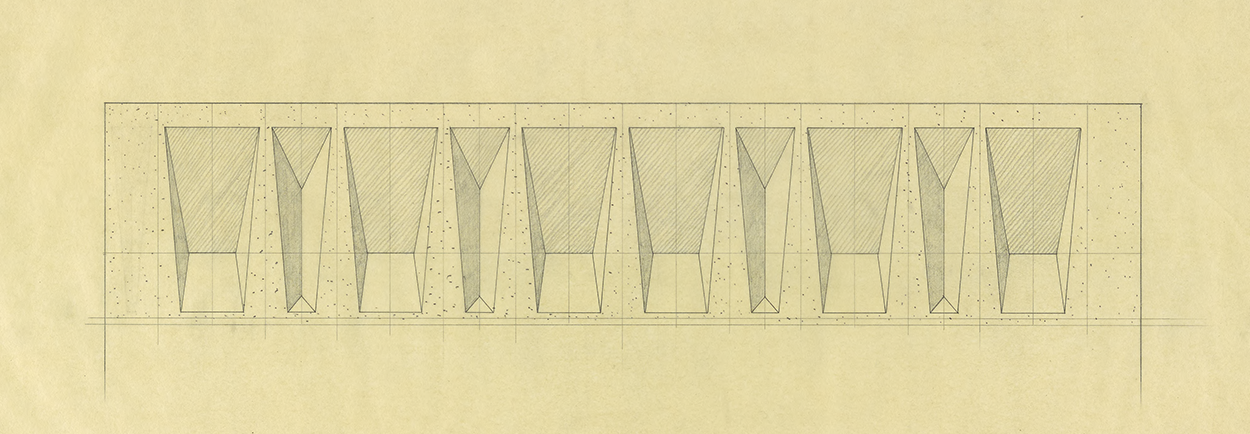Creating the Digital Archive
The Marcel Breuer Digital Archive (MBDA) is a collaborative effort led by Syracuse University Libraries that digitized nearly 80,000 drawings, photographs, letters, and other materials related to the career of Marcel Breuer, a highly influential architect and furniture designer of the twentieth century. Beginning in 2009, the project was completed in two phases with funding from the National Endowment for the Humanities (NEH):
- The first phase supported physical processing of materials; selection and digitization of content up to 1953 (culminated in the design of the UNESCO headquarters by Breuer in the mid-1950s); construction of a separate database to support the creation of METS (metadata encoding transmission standard) files informing the descriptive, administrative, and structural metadata associated with the objects; development of a Breuer-specific application profile; creation of detailed descriptive metadata; and the initial publication of the website in 2012. A snapshot of this early site was captured by the Internet Archive’s Wayback machine and can be viewed at this archive URL: https://web.archive.org/web/20120329023603/http://breuer.syr.edu/
- The second phase focused on digitizing and describing materials from the second half of Breuer’s career (1953-1981).
While a significant accomplishment of its time, the MBDA was migrated in 2024 to a new access platform (AM Quartex) and the digital surrogates were added as archival primary files to the Libraries’ digital preservation system (Preservica). The migration to the new system will allow for easier updates to the content and a variety of new, interpretative interfaces still to be imagined and realized. This new platform also ushers in a new era of researchers working with this important corpus alongside a whole host of potential teaching and learning opportunities and digital scholarship projects through enhanced search engine optimization and opportunities for broader aggregation and publication.
The MBDA is the product of an interdisciplinary team of librarians, archivists, scholars, programmers, and vendors. Special thanks go to various individuals and partner institutions involved in this significant endeavor, including (but not limited to): Brett Barrie, Jean Francois Bedard, Barry Bergdoll, Anthony Carbone, Michele Combs, Matthew Dames, Michael Dermody, Amy Dygert, Daniel Hanks, Jr., Teresa Harris, Cristina Hatem, Hudson Microimaging, Isabelle Hyman, Kiley Jolicoeur, Déirdre Joyce, Jonathan Massey, Amy MacDonald, Pamela McLaughlin, Sebastian Modrow, Lucy Mulroney, Nicholas Nosko, Sarah Pohley, Suzanne Preate, Sean Quimby, Daniel Rice, Charles Russo, Daniel Sarmiento, Corinne Sartori, David Seaman, Russell Silverstein, David Stokoe, Suzanne Thorin, Nicole Westerdahl, our dedicated student workers, and all our contributing partner institutions.
Creating the Digital Archive
The Marcel Breuer Digital Archive (MBDA) is a collaborative effort led by Syracuse University Libraries that digitized nearly 80,000 drawings, photographs, letters, and other materials related to the career of Marcel Breuer, a highly influential architect and furniture designer of the twentieth century. Beginning in 2009, the project was completed in two phases with funding from the National Endowment for the Humanities (NEH):
- The first phase supported physical processing of materials; selection and digitization of content up to 1953 (culminated in the design of the UNESCO headquarters by Breuer in the mid-1950s); construction of a separate database to support the creation of METS (metadata encoding transmission standard) files informing the descriptive, administrative, and structural metadata associated with the objects; development of a Breuer-specific application profile; creation of detailed descriptive metadata; and the initial publication of the website in 2012. A snapshot of this early site was captured by the Internet Archive’s Wayback machine and can be viewed at this archive URL: https://web.archive.org/web/20120329023603/http://breuer.syr.edu/
- The second phase focused on digitizing and describing materials from the second half of Breuer’s career (1953-1981).
While a significant accomplishment of its time, the MBDA was migrated in 2024 to a new access platform (AM Quartex) and the digital surrogates were added as archival primary files to the Libraries’ digital preservation system (Preservica). The migration to the new system will allow for easier updates to the content and a variety of new, interpretative interfaces still to be imagined and realized. This new platform also ushers in a new era of researchers working with this important corpus alongside a whole host of potential teaching and learning opportunities and digital scholarship projects through enhanced search engine optimization and opportunities for broader aggregation and publication.
The MBDA is the product of an interdisciplinary team of librarians, archivists, scholars, programmers, and vendors. Special thanks go to various individuals and partner institutions involved in this significant endeavor, including (but not limited to): Brett Barrie, Jean Francois Bedard, Barry Bergdoll, Anthony Carbone, Michele Combs, Matthew Dames, Michael Dermody, Amy Dygert, Daniel Hanks, Jr., Teresa Harris, Cristina Hatem, Hudson Microimaging, Isabelle Hyman, Kiley Jolicoeur, Déirdre Joyce, Jonathan Massey, Amy MacDonald, Pamela McLaughlin, Sebastian Modrow, Lucy Mulroney, Nicholas Nosko, Sarah Pohley, Suzanne Preate, Sean Quimby, Daniel Rice, Charles Russo, Daniel Sarmiento, Corinne Sartori, David Seaman, Russell Silverstein, David Stokoe, Suzanne Thorin, Nicole Westerdahl, our dedicated student workers, and all our contributing partner institutions.

